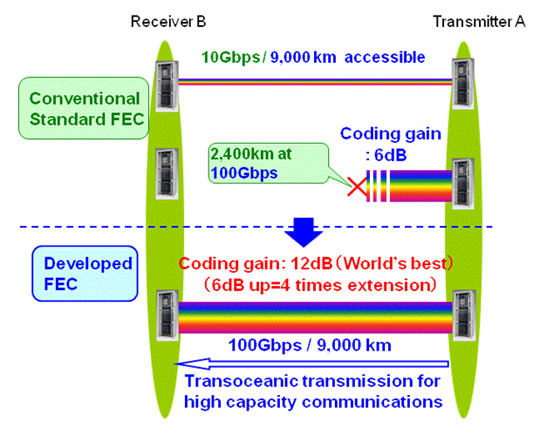News Release Archives
Note that the releases are accurate at the time of publication but may be subject to change without notice.
FOR IMMEDIATE RELEASE No. 2734
Mitsubishi Electric Develops World's Best Error-correction Technology for High-capacity Optical Communication
TOKYO, February 14, 2013 - Mitsubishi Electric Corporation (TOKYO: 6503) announced today it has developed an error-correction technology that achieves a coding gain of 12.0dB, the world's highest level as of February 14, 2013 according to internal research, for high-speed and high-capacity optical communication systems over long distances. The technology will be launched in the fiscal year starting in April 2014.

Error-correction technology allows a sender to encode a message with redundancy by using error-correction codes. Coding gain is the difference in the signal-to-noise ratio (SNR) levels between uncoded and coded systems required to reach the same bit error rate (BER) levels when used with the error-correction code. Mitsubishi Electric's new error-correction technology enables transmissions four times longer than conventional codes, such as Reed-Solomon codes standardized by ITU-T G.709. As a result, the technology enables long-haul transoceanic transmissions, such as those between Japan and the United States (about 9,000km), at 100Gbps per wavelength for high-capacity communication systems.
Error-correction technology allows a sender to encode a message with redundancy by using error-correction codes. Coding gain is the difference in the signal-to-noise ratio (SNR) levels between uncoded and coded systems required to reach the same bit error rate (BER) levels when used with the error-correction code. Mitsubishi Electric's new error-correction technology enables transmissions four times longer than conventional codes, such as Reed-Solomon codes standardized by ITU-T G.709. As a result, the technology enables long-haul transoceanic transmissions, such as those between Japan and the United States (about 9,000km), at 100Gbps per wavelength for high-capacity communication systems.

Key Features

Specifications

Data communication traffic has expanded rapidly due to the proliferation of smartphones and the expansion of video-on-demand services, resulting in the need for optical submarine communication systems that can achieve high-speed, high-capacity communications at 40Gbps/100Gbps throughput rather than the conventional 10Gbps. However, faster transmission speeds in optical communications result in greater noise on optical channels, and conventional error-correction codes have difficulties with 100Gbps per wavelengths for long-distance transoceanic transmissions. Mitsubishi Electric's high-performance error-correction technology responds to this demand for high-performance error correction.

Pending patents for the technology number three in Japan and one overseas.

This research was in part supported by the "Lambda Reach Project" of the National Institute of Information and Communication Technology (NICT) of Japan.
World's best error-correction technology
|
Specifications
| Error-correction code | Coding gain | Transmission distance/ Transmission speed |
|
| New code | LDPC code + BCH code | 12.0dB | 9,000km/100Gbps |
| Standard code (ITU-T G.709) |
Reed-Solomon code | 6.0dB | 2,400km/100Gbps |
Data communication traffic has expanded rapidly due to the proliferation of smartphones and the expansion of video-on-demand services, resulting in the need for optical submarine communication systems that can achieve high-speed, high-capacity communications at 40Gbps/100Gbps throughput rather than the conventional 10Gbps. However, faster transmission speeds in optical communications result in greater noise on optical channels, and conventional error-correction codes have difficulties with 100Gbps per wavelengths for long-distance transoceanic transmissions. Mitsubishi Electric's high-performance error-correction technology responds to this demand for high-performance error correction.
Pending patents for the technology number three in Japan and one overseas.
This research was in part supported by the "Lambda Reach Project" of the National Institute of Information and Communication Technology (NICT) of Japan.